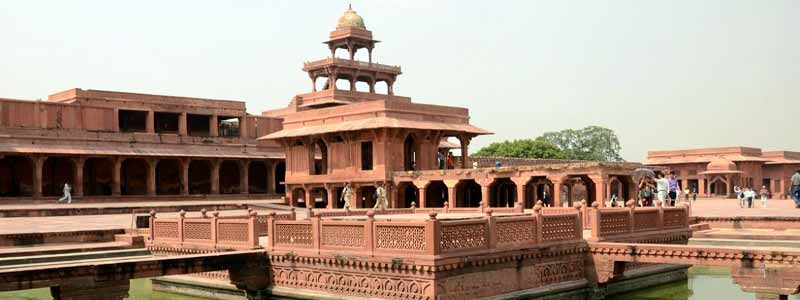What Is Fatehpur Sikri Famous For? is a historic city located near Agra in Uttar Pradesh, India. It is famously known as the “City of Victory” and holds immense historical, architectural, and cultural significance. Built in the 16th century by the Mughal Emperor Akbar, Fatehpur Sikri served as the capital of the Mughal Empire for a brief period from 1571 to 1585.
One of the most notable reasons for its fame is its stunning Mughal architecture. The city showcases a unique blend of Islamic, Hindu, and Persian styles, with beautifully carved red sandstone buildings. Some of the most famous structures within Fatehpur Sikri include the Buland Darwaza (Gate of Magnificence), the highest gateway in the world; Jama Masjid, a grand mosque; Panch Mahal, a five-storey palace; Diwan-i-Khas and Diwan-i-Aam, the halls for private and public audiences; and Jodha Bai’s Palace, which reflects Rajput architectural influences.
Fatehpur Sikri is also closely associated with Sufi saint Sheikh Salim Chishti, whose blessing is believed to have led to the birth of Akbar’s heir, Jahangir. His white marble tomb, located in the courtyard of Jama Masjid, remains a major pilgrimage site.
Despite its grandeur, the city was abandoned due to water shortages and political reasons, yet its monuments remain remarkably well-preserved. Today, Fatehpur Sikri is recognized as a UNESCO World Heritage Site and is a major tourist attraction, drawing visitors for its historical richness, spiritual significance, and architectural beauty. It stands as a testament to Akbar’s vision and the cultural harmony of the Mughal era.

History of Fatehpur Sikri
Fatehpur Sikri, located near Agra in Uttar Pradesh, was founded in 1571 by the Mughal Emperor Akbar. The city was built to honor the revered Sufi saint Sheikh Salim Chishti, who had predicted the birth of Akbar’s heir, Prince Salim (later Emperor Jahangir). Named “Fatehpur” meaning “City of Victory,” it served as the capital of the Mughal Empire for about 14 years.
Akbar designed the city as a grand architectural and cultural center, blending Persian, Islamic, and Indian styles. Fatehpur Sikri featured majestic palaces, mosques, and public buildings, including the Buland Darwaza, Jama Masjid, and Diwan-i-Khas. It was also a symbol of Akbar’s policy of religious tolerance, with the Ibadat Khana serving as a space for interfaith dialogue.
However, due to water scarcity and growing political challenges, the city was abandoned in 1585. Despite its brief prominence, Fatehpur Sikri remains a remarkable legacy of Mughal urban planning and imperial vision.
Architecture of Fatehpur Sikri
The architecture of Fatehpur Sikri is a magnificent fusion of Persian, Islamic, and Indian styles, reflecting Emperor Akbar’s vision of cultural and religious integration. Constructed primarily from red sandstone, the city showcases the grandeur of Mughal design through its symmetrical planning, ornate carvings, and elegant structures.
Key architectural highlights include the Buland Darwaza, a 54-meter-high gateway built to celebrate Akbar’s victory in Gujarat, and the Jama Masjid, one of India’s largest mosques. The Tomb of Sheikh Salim Chishti, made of white marble with delicate latticework, stands out for its spiritual significance and artistic detail.
Palaces like Jodha Bai’s Palace and Birbal’s House display Hindu motifs, chhatris (domed pavilions), and intricate jali screens. The Diwan-i-Khas, with its central carved pillar, and the five-story Panch Mahal, designed for leisure and ventilation, exemplify functional elegance.
Fatehpur Sikri’s architecture is not only aesthetically stunning but also represents Akbar’s ideals of tolerance, innovation, and imperial grandeur—making it one of India’s finest heritage sites.
Best Places To Visit In Fatehpur Sikri
Fatehpur Sikri is home to a wealth of historical and architectural treasures that reflect the grandeur of the Mughal era. Here are the top places to explore:
Buland Darwaza: This towering gateway stands 54 meters high and was built by Akbar to commemorate his victory in Gujarat. Its intricate carvings and massive structure make it one of the most iconic monuments in India.
Jama Masjid: One of the largest mosques in India, this impressive structure is known for its vast courtyard and Indo-Islamic architecture. It remains a functioning mosque and an important place of worship.
Tomb of Sheikh Salim Chishti: Built in white marble, this serene tomb honors the Sufi saint whose blessing led to Akbar’s son’s birth. Devotees often tie threads on its jalis (latticed screens) for wishes.
Diwan-i-Khas: The Hall of Private Audience is known for its intricately carved central pillar supporting a platform, symbolizing Akbar’s inclusive rule.
Panch Mahal: A five-story pavilion with diminishing tiers, it was designed for queens and court ladies to enjoy cool breezes and observe court activities.
Jodha Bai’s Palace: This palace blends Hindu and Islamic styles and served as the residence of Akbar’s Rajput queen.
Birbal’s House: A richly decorated structure believed to be the residence of Akbar’s trusted advisor, Birbal.
Each monument tells a story of artistic brilliance, cultural fusion, and imperial vision.
How to Reach Fatehpur Sikri
Fatehpur Sikri is well-connected by road, rail, and air, making it accessible from major cities like Agra, Delhi, and Jaipur.
By Road: Fatehpur Sikri is about 40 km from Agra and can be easily reached by car, taxi, or bus. Regular UPSRTC and private buses run from Agra, taking around 1 to 1.5 hours. It is located on the Agra–Jaipur Highway (NH 21), so it’s convenient for travelers coming from Jaipur (approx. 200 km) and Delhi (approx. 230 km).
By Train: Fatehpur Sikri has a small railway station named Fatehpur Sikri Railway Station (FTS), about 1 km from the monument complex. However, it is served by a limited number of trains. For better connectivity, you can arrive at Agra Cantt Railway Station, which is well-connected to all major Indian cities, and then take a taxi or bus to Fatehpur Sikri.
By Air: The nearest airport is Agra Airport (AGR), around 40 km away. Alternatively, Delhi’s Indira Gandhi International Airport (approx. 230 km) offers broader connectivity and car rental options for a road trip to What Is Fatehpur Sikri Famous For?.
